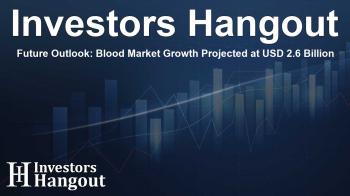Future Outlook: Blood Market Growth Projected at USD 2.6 Billion

Insights into the Expanding Blood Market
The global blood market is set for substantial growth, projected to increase by USD 2.6 billion between 2024 and 2028. This impressive growth is underpinned by advancements in healthcare infrastructure, with hospitals and blood banks playing a pivotal role in meeting the rising demand for blood and its components. As awareness about blood donation continues to rise, we see a corresponding increase in the availability and collection of blood, further bolstering the market.
Market Growth Drivers
Demand for Blood Components
The demand for vital body fluids such as red blood cells and plasma is significantly increasing, primarily for treatments related to chronic medical conditions like leukemia, cancer, and anemia. Blood plays an essential role in various medical procedures, including organ transplants, cardiac surgeries, and trauma care. The increasing number of hospitals and advanced health facilities translates directly into a greater need for blood collection and transfusion services.
Healthcare Expenditure Trends
Continuous growth in healthcare expenditure is another driving factor for the blood market. As hospitals invest more in technology and process improvements, the efficiency of blood collection, typing, and screening services is expected to rise. Blood collection devices, equipped with advanced technology designed for minimizing contamination and mishandling, also contribute to a more dependable blood supply.
Challenges in the Blood Market
Rural Healthcare Limitations
Despite the growth opportunities, the blood market faces challenges, particularly regarding the provision of adequate blood supply in rural regions. These areas often lack sufficient storage facilities and healthcare infrastructures, making it difficult to meet local demand. Consequently, there is a need for more investment in blood services to improve accessibility in these underserved locations.
Managing Supply and Demand
Another significant challenge is ensuring a steady supply of blood to meet fluctuating demand. Events such as natural disasters, emergencies, and seasonal illnesses can drastically affect supply levels. Health organizations and blood banks need to be proactive in their collection efforts, especially during peak times, to avoid shortages.
Market Segmentation
Product Categories
The blood market encompasses various product categories, including whole blood, plasma, and blood screening products. Understanding these segments helps stakeholders identify opportunities for growth and innovation.
Geographical Insights
Geographically, the blood market shows significant performance in regions like North America, Asia, and Europe, with North America comprising the largest share. The varying healthcare needs across different locales necessitate tailored strategies by market players to effectively cater to local demands.
Technological Advancements Shaping the Industry
With Artificial Intelligence driving changes in many sectors, the blood market is also witnessing innovations that enhance efficiency and safety. AI technologies can optimize blood screening processes and improve inventory management in blood banks, ensuring that the right amount of blood is available at the right time.
About Technavio
Technavio is a leading global technology research and advisory firm. Their comprehensive research spans numerous technologies and industries, offering actionable insights that help businesses stay ahead in the market. With a dedicated team of analysts, Technavio provides valuable data and metrics to aid strategic decision-making in the blood market and beyond.
Frequently Asked Questions
1. What is the projected growth of the blood market from 2024-2028?
The blood market is projected to grow by USD 2.6 billion during this period, reflecting a robust market expansion driven by increased healthcare needs.
2. What are the main drivers of market growth?
The main drivers include the rising demand for blood components due to chronic medical conditions, the expansion of hospitals and blood banks, and increased healthcare expenditure.
3. What challenges does the blood market face?
The market faces challenges related to rural healthcare limitations and managing the balance between supply and demand during emergencies and peak times.
4. How does AI impact the blood market?
AI technologies enhance operational efficiency in blood screening, optimize donor matching, and improve overall inventory management in blood services.
5. Why is education about blood donation important?
Increasing awareness and education about blood donation can significantly enhance the number of individuals willing to donate, thus strengthening blood supply systems.
About Investors Hangout
Investors Hangout is a leading online stock forum for financial discussion and learning, offering a wide range of free tools and resources. It draws in traders of all levels, who exchange market knowledge, investigate trading tactics, and keep an eye on industry developments in real time. Featuring financial articles, stock message boards, quotes, charts, company profiles, and live news updates. Through cooperative learning and a wealth of informational resources, it helps users from novices creating their first portfolios to experts honing their techniques. Join Investors Hangout today: https://investorshangout.com/
Disclaimer: The content of this article is solely for general informational purposes only; it does not represent legal, financial, or investment advice. Investors Hangout does not offer financial advice; the author is not a licensed financial advisor. Consult a qualified advisor before making any financial or investment decisions based on this article. The author's interpretation of publicly available data shapes the opinions presented here; as a result, they should not be taken as advice to purchase, sell, or hold any securities mentioned or any other investments. The author does not guarantee the accuracy, completeness, or timeliness of any material, providing it "as is." Information and market conditions may change; past performance is not indicative of future outcomes. If any of the material offered here is inaccurate, please contact us for corrections.
